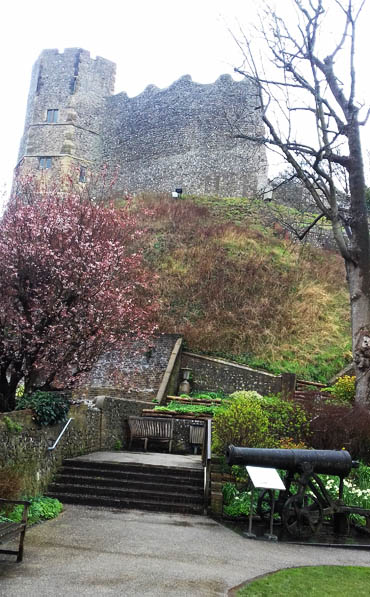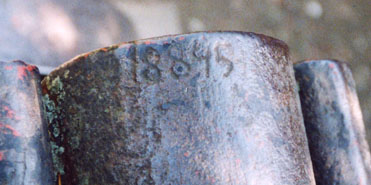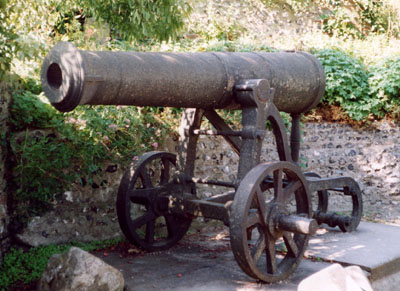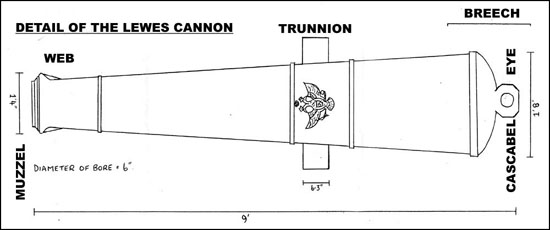
HOME





HOME
|

|

|

|

|
|
P R O F I L E |
||||
|
  CRIMEAN CANNONS - WHERE ARE THEY NOW?
CRIMEAN CANNONS - WHERE ARE THEY NOW?Castle Grounds 169 High Street Lewes East Sussex England BN7 1YE Telephone: 01273 486290 Clark records in Lost Lewes (2001) that the town of Lewes in Sussex also received a Crimea Gun that was displayed in the Gun Garden by the Castle Lodge. In 2005 the gun is still to be seen in the corner of the Gun Garden to which it gives its name. According to the Castle Museum Guide Book, this has been the site of the cannon since 1923 although it has been in the castle grounds since 1858. Lord Panmure presented the gun to Lewes in recognition of the period when 300 Finnish and Russian prisoners were billeted here after the battle at Bomarsund in 1854. The Naval Prison in North Street accommodated some whilst others had accommodation within the town. Such arrangements meant that the prisoners integrated with the social scene but returned home in 1856, when they were escorted to the railway station by the town band. The cast iron smooth bore cannon bears the Russian Eagle on the second reinforce and the number 18845 on the top of the left trunnion.  If this is the original number, usually on the trunnion end, it would date this piece to 1827/8. (Robins suggests 1823/4) The Cyrillic on the ends of the trunnions is unreadable. The gun is sitting on the Venglov carriage, which was manufactured at Woolwich Arsenal. If this is the original number, usually on the trunnion end, it would date this piece to 1827/8. (Robins suggests 1823/4) The Cyrillic on the ends of the trunnions is unreadable. The gun is sitting on the Venglov carriage, which was manufactured at Woolwich Arsenal.
The following account is an abbreviation of a document supplied by Lewes Castle and Museums. THE CANNON, GUN GARDEN. LEWES CASTLE. The cannon was presented to the Town of Lewes in 1858 by the then Secretary of State for War, Lord Panmure, in recognition of the town's service during the Crimean War of 1854-1856. The war was fought mainly in the Crimea region of Russia on the Black Sea. The coalition forces of England and France did undertake one Naval expedition in the Baltic, in an attempt to reach the Russian second capital of St. Petersburg. The Allied Fleet began the Seige of the Fortress of Bombarsund. This was one the largest defensive forts ever built, situated on one of the islands of the Archipelago of Aland, defending the approaches to St. Petersburg. In the July of 1854, it finally fell, and was destroyed in the September. Some 2000 Russian and Finnish Prisoners were taken and sent back to England. Finland was regarded, at that time, as part of Russia after it's annexation in 1810. The Old House of Correction in North Street, Lewes (now the site of the Ambulance Station and a car park) had been hastily converted to a Naval Prison. 300 of the captured Finns and their Russian officers were brought to Lewes and put into the Naval Prison. The Prison no longer exists but a monument commemorating those that died whilst in prison was erected in the graveyard of St. John Sub Castro late last century, it was repaired by the Soviet Embassy in the 1950s. The cannon was however was likely captured after the siege of Sevastapol where it would have formed part of the armament of a fort redoubt or garrison. It bears the arms of Imperial Russia on the barrel - a two headed Eagle, each crowned, wings spread, carrying an orb and sceptre in it's talons. A shield on its breast is the Moscow crest of St.George slaying the Dragon, surmounted overall by the Imperial Crown. Although the British had exercised considerable influence over Russian ordinance design two features make this piece typical Russian. The horizontal 'cascable' eye at the breech and the 'webs' at the muzzle. (4) Nine foot long and weighing 2 tons, the gun is smooth bored and would have been used to fire solid iron round shot, weighing 24/26 pounds. In military parlance the gun would have been called a 24 pounder. Such a shot, or cannon ball, with a charge of 8-10 pounds of powder would have a range of up to 1-1.5 miles, although really only effective within 400-600 yards. Canister shot comprising hundreds of small lead shot packed into a tin closed cylinder, used against soldiers advancing in close order.  Explosive shell, later modified and renamed Shrapnel, consisting of a hollow iron sphere filled with powder, fitted with a fuse, timed to burst over personnel.
Explosive shell, later modified and renamed Shrapnel, consisting of a hollow iron sphere filled with powder, fitted with a fuse, timed to burst over personnel.
Grape shot, the same principle as canister, but with much larger iron balls was also used, particularly effective against horses deployed en mass eg. cavalry. Between 6-8 men would have serviced a piece such as this. The routine for loading and firing was: - I The bore was sponged out to dampen any sparks from the last firing and to soften any soot. 2 A canvas or paper cartridge, filled with the correct weight of powder, was then rammed down the barrel to the breech. 3 A hole was pierced in the cartridge through the touchhole in the top of the barrel, the touchhole then being 'primed' with powder. 4 Next the type of shot required was rammed home. 5 The entire cannon was then aimed (or sighted ) by means of manually moving it to one side or the other for direction and inserting a correct bar for the elevation. 6 The cannon was then manually hauled up to firing position by means of drag ropes running through the cascable eye. 7 The gun was fired by 'touching' the powder in the touch hole with a lighted fuse (or linstock), the powder ignited and travelled down the hole to the cartridge which exploded, the force of the explosion forcing the shot out of the barrel. 8 The fall of the shot observed, the process began again. A well-practised crew of gunners could fire such a gun in this manner at a rate of 3 times every 5 minutes. Such rates of fire, however, lead to problems. Each time the gun was fired, the explosion in the breech weakened it and ultimately the gun 'breeched', that is the touch hole blew out or, even worse and considerably the more dangerous to the crew - the entire breech exploded. The most fatal of problems came after continuous fire. The barrel became so hot that it distorted and the shot rammed down the barrel became stuck half way, in the heat of battle the gunner gave the order to fire and, without 'windage' ie. a slight gap between the shot and the barrel side, the whole cannon exploded. Although used in the Crimea this type of smooth bore cannon became totally obsolete after 1860/5 and the advent of breech loading, rifled artillery. 
The following is from Smith V. The Town Book of Lewes 1837-1901, Lewes, Sussex Record Society (1975). RUSSIAN TROPHY A wish having been expressed by many of the Inhabitants that this Ancient County Town should be honoured with some Russian Trophy application was made in October last by the Chief Officers of the Borough supported by the Borough Members to Lord Panmure who was at that time Secretary of State for War ex-pressing a hope that his Lordship would be pleased to present this Town with a Russian Gun to be preserved as a Trophy of the late War and calling his Lordship's attention to the Fact that about 300 Russian War prisoners were confined here during the late War. The application was favourably received by his Lordship who stated he had much pleasure in presenting to the County Town of Lewes a Russian Gun which was taken during the late War and his Lordship at the same time offered to have a Russian Gun Carriage Manufactured for it at the Royal Arsenal at Woolwich if wished which offer was at once accepted. The Gun and Carriage arrived here in June last and it has since been mounted in the Grounds of the Castle. A Subscription was raised for the purpose of paying for the Gun Carriage and other expenses in connection therewith. A clearer picture emerges of the captured prisoners stay in Lewes from an article in 'Leisure Hour' of 1855. From the article we can deduce that there were more than 2000 surrendering troops of which about 400 were transported to Lewes. This was after the fall of Bomersund summer 1854. They were principally Finnish grenadier rifles and belonged to the regular Russian army. Included were nine officers who were paroled to private lodgings in town. Two had their wives with them. The majority of prisoners however were housed in the goal, including two further wives who were allowed into town for errands and shopping. The officers displayed characteristics of the upper classes of society and indulged in social intercourse with the gentry of the neighborhood. The Tsar had provided funds for the Officers welfare and one of the wives gave birth during the custody, an event that precipitated a debate on the nationality of the offspring which is was generally felt should be regarded as English. The ranks however fared quite well also. Although described as heavy and unprepossessing in appearance, they were clearly not wanting of intelligence and almost disappointed the local populace by not displaying the brutality and cunning expected. Having entered the Tsarís army some four years previous, they were described as kind and courteous, active, industrious and methodical. It was especially noted, possibly with some surprise, that they chanted a hymn before meals. Dress was mainly that in which they were captured, except officers, who wore either dark blue dress uniforms with silver buttons or dressed down. The women were considered gentile and good looking. Accommodation comprised stone wards heated by water pipes. Cleanliness prevailed and proceedings were conducted with great order and regularity. Food was of good quality including beef and potatoes and their preponderance to use large quantities of salt was noted. Many of the prisoners occupied their time by carving trinkets in wood. These playthings and ornaments were then sold in a bazaar set up for the purpose. This resulted in an influx of visitors from Brighton and considerable profits were made as a result. As many as 1500 visitors in a single day were counted and the ensuing revenue enabled the prisoners to provide themselves with many comforts. The health of the inmates improved considerably during their stay and it was decided to let them recreate on the Downs. This caused some alarm amongst the prisoners who thought that they were being taken to be executed. The influx of these captives resulted in a harmonious relationship with the townsfolk and it was hoped that they would eventually return to their homeland with recollections of kindness and understanding, when in the hands of the English. The local lads even refrained from burning effigies of the Tsar at the annual bonfire celebrations, such was the relationship between the two warring sides. Source; The War Correspondent, Vol. 23 No 2 July 2005, Crimean War Research Society. Email: cannon@thespas.co.uk (click here to send an email) Website: Click Here ADDITIONAL INFORMATION  REGION England - Southern THE FEATURES PRESENT Crimean Cannon Location, past or present |
||||
|